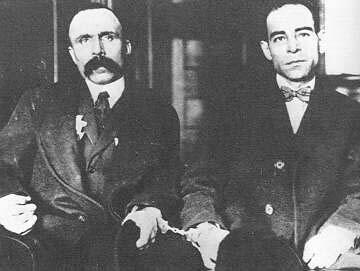- Trial Court Law Libraries
Their subsequent trial and execution became an international causecélèbre. While the press used Vanzetti’s words to characterize the two as the “good shoemaker” and the “poor fish peddler,” they were committed anarchists. It was widely thought that they were tried for their political convictions instead of the alleged crime. They maintained their innocence for seven years before they were electrocuted on August 23, 1927. In that time, they garnered the support of countless legal scholars, writers, artists and thousands of ordinary working people all over the world. Five days after their execution, the funeral procession through the streets of Boston drew two hundred thousand mourners.
Their guilt or innocence in the murders has long been debated. But less contentious is the proposition that they should have been tried for criminal deeds, not political stances. This particular case holds a pivotal place in Massachusetts legal history because of the attention that it garnered and the reforms that followed. All three branches of government made contributions to the resulting law.
Judicial branch: Excerpts from the trial transcript, a summary of the evidence and statements made at sentencing are available on Douglas O. Linder’s “Famous Trials” website. Numerous motions for a new trial were filed between 1921 and 1926. The Massachusetts Supreme Judicial Court denied motions based on alleged trial errors and erroneous rulings of law (255 Mass 369), and newly discovered evidence and Celestino F. Madeiros’ confession (259 Mass 128). The Supreme Judicial Court has compiled a history.
Legislative branch: “The Judicial Council of Massachusetts [was] a bar advisory group formed in 1924 to make recommendations to the Governor and Legislature regarding improvement of the state’s system of justice… In 1939, following recommendations of Judicial Council, the Legislature passed the present Mass. G. L. c. 278, § 33E. This statute provides that in any case in which a defendant has been convicted of murder in the first degree, the Supreme Judicial Court must review both the law and the evidence.” *
Executive branch: Vanzetti wrote an appeal for clemency on May 3, 1927. On August 3, 1927, Governor Fuller denied the appeal.
On the 50th Anniversary of the executions of Sacco and Vanzetti, Governor Michael Dukakis asked his Chief Legal Counsel to prepare a report to determine if “there are substantial grounds for believing . . that Sacco and Vanzetti were unfairly convicted and executed, and if so, what action can appropriately be taken.” According to the report, the law made no provision for a posthumous pardon. Subsequently, Governor Dukakis’ issued a Proclamation recognizing “Nicola Sacco and Bartolomeo Vanzetti Memorial Day.”
From Sacco and Vanzetti: Justice on Trial, a permanent exhibit open to the public at the John Adams Courthouse in Boston, with an online component available.

